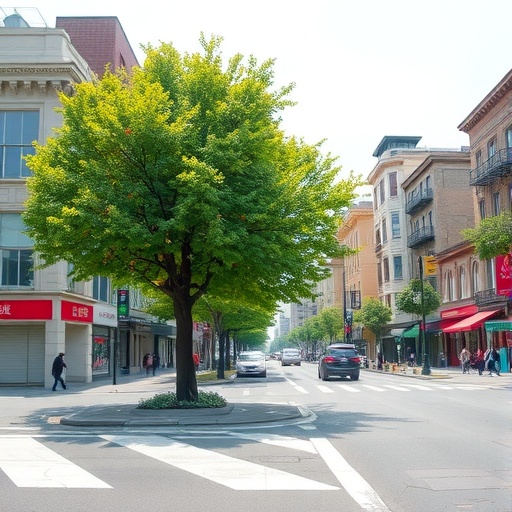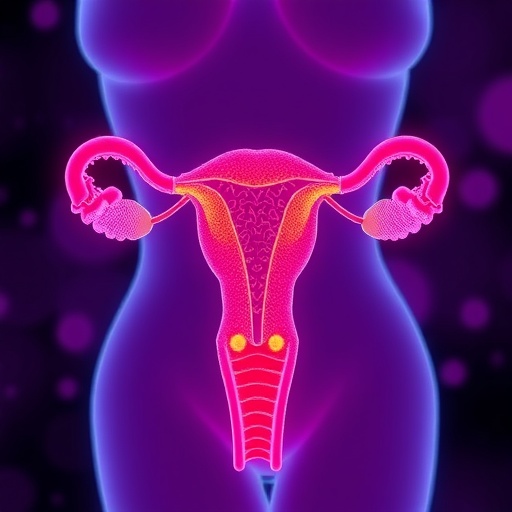As urban landscapes continue their relentless expansion, a silent and often overlooked battle unfolds beneath our feet and along our city streets: the health and resilience of urban trees and their microbial companions. Urban trees are not just aesthetic fixtures in concrete jungles; they are vital to the ecological and human health of cities worldwide. A groundbreaking study led by researchers from Boston University’s Bhatnagar Lab reveals that urbanization severely disrupts the intricate microbiomes that support tree vitality, offering new insights into the hidden microbial dynamics shaping our urban ecosystems.
Microbial communities associated with trees—their microbiomes—play critical roles in supporting tree growth, nutrient cycling, and resilience against environmental stressors. These microorganisms include beneficial fungi such as ectomycorrhizal fungi, essential partners that colonize tree roots and enhance nutrient uptake, as well as bacteria that contribute to carbon and nitrogen cycling. However, the stresses imposed by urban environments—ranging from increased heat and air and soil pollution to fragmented habitats—are profoundly altering these microbial assemblages, often to the detriment of tree health.
The recent study, published in Nature Cities, focused specifically on the microbiomes of oak trees, a common ectomycorrhizal species, comparing urban street trees with those in rural forests. Through meticulous analysis of fungal and bacterial diversity, tree physical characteristics, and soil properties, lead researchers Jenny Bhatnagar and Kathryn Atherton uncovered a disturbing pattern: urban trees suffer from a pronounced loss of beneficial microbes alongside an increased presence of pathogens and microbes capable of generating potent greenhouse gases like nitrous oxide.
One of the most striking findings is the loss of ectomycorrhizal fungi in urban tree roots. These fungi are known to form symbiotic associations that not only aid in nutrient acquisition—particularly phosphorus and nitrogen—but also enhance water absorption and provide protection against diseases. Without these critical partners, urban trees are left vulnerable to a cascade of stressors, including drought and soil compaction. Concurrently, urban trees accumulate more pathogenic fungi and bacteria which can exacerbate wood rot and other diseases, undermining tree longevity.
Furthermore, the study highlights that urban tree microbiomes harbor more bacterial species capable of producing nitrous oxide (N2O), a greenhouse gas with a global warming potential approximately 300 times greater than carbon dioxide. Conversely, methanogens, bacteria that consume methane and thus mitigate greenhouse gas emissions, are less abundant beneath urban trees compared to their rural counterparts. This shift suggests that urban tree-associated microbial communities could inadvertently contribute to urban greenhouse gas emissions, compounding climate concerns.
The disruption to tree microbiomes is closely tied to specific urban environmental conditions—higher temperatures caused by urban heat islands, reduced soil moisture, degraded soil organic matter, and increased deposition of atmospheric aerosols and pollutants. These factors directly and negatively influence microbial diversity and function, creating a hostile environment for many of the beneficial organisms crucial for tree health.
Although the study centers on oak trees, which depend on ectomycorrhizal fungi, the researchers suggest that similar disruptions may affect other tree species and plants that rely on different types of symbiotic fungi or microbial communities. However, this remains an open question and a ripe area for future investigation, emphasizing the need to broaden the scope of urban microbiome research across diverse urban flora.
Understanding these microbial relationships is more urgent than ever given the rapid pace of urban growth worldwide. It is estimated that urban areas will double in size by 2050, with profound implications for natural habitats and the resilience of urban ecosystems. In the United States alone, over 20% of forest land is projected to be overtaken by urban expansion by mid-century, with 90% of the population living in cities. The health of urban tree populations will directly impact air quality, carbon sequestration, urban cooling, and biodiversity conservation.
Another compelling aspect of this research is its application potential. By identifying the key environmental drivers behind microbiome disruption, such as soil organic matter decline and moisture stress, urban planners and environmental managers can implement targeted strategies to restore and maintain microbial diversity. Simple interventions like adding mulch around trees to improve soil moisture and organic content could foster the recovery of beneficial microbial symbionts, enhancing tree stress tolerance and longevity.
Importantly, the research team is pioneering “microbiome rewilding” experiments aimed at reintroducing beneficial mycorrhizal fungi into urban soils. This approach draws inspiration from forest restoration ecology, where inoculating tree roots with mutualistic fungi has successfully reduced mortality rates. Rewilding urban tree microbiomes has the potential to transform city landscapes into thriving ecosystems, improving tree survival rates and the ecological services they provide.
From a broader perspective, integrating microbiome knowledge into urban forestry policy could revolutionize how cities manage their green spaces. Microbial considerations could enhance urban tree resilience, improving ecosystem services such as air pollution filtration, carbon capture, and microclimate regulation, while also contributing to more equitable access to healthy green spaces across socio-economic boundaries.
In addition to informing urban management, these findings have implications for public engagement. Understanding that the tiny organisms beneath a tree’s surface can drastically affect its health and the broader urban environment encourages a shift in how individuals and communities care for urban trees. Simple actions like applying mulch and advocating for green infrastructure can support these complex microbial networks and contribute to healthier urban forests.
The study reminds us that urban trees are not solitary organisms but are embedded in intricate and dynamic relationships with countless microbial partners. As urban pressures escalate, safeguarding these invisible communities is critical to preserving urban forest health, mitigating climate impacts, and enhancing the quality of urban life. The research from Boston University opens new horizons, signaling a paradigm shift toward viewing urban vegetation through the lens of microbial ecology, with profound consequences for sustainable urbanization worldwide.
The path forward involves rigorous exploration of the specific microbial and environmental factors that most strongly predict urban tree health outcomes. Advanced modeling efforts are underway to delineate these relationships, hopefully enabling the identification of priority targets for urban afforestation and management practices. Coordinated interdisciplinary efforts that unite microbiologists, ecologists, urban planners, and policymakers will be vital in translating these findings into actionable solutions.
This research also underscores the broader implications of urban environmental change on interconnected ecosystems, human health, and climate dynamics. As cities aspire toward net-zero emissions and climate resilience, the microbiological underpinnings of urban forests must be elevated to a central role in scientific inquiry and practical interventions.
By shedding light on the complex microbial dimensions of urban tree health and offering promising avenues for remediation, this study serves as a call to action for researchers, city officials, and residents alike. The future of urban trees—and by extension, urban life—depends on recognizing and nurturing the invisible microbial allies beneath our feet.
Subject of Research:
Not applicable
Article Title:
Disruption of the oak tree microbiome with urbanization
News Publication Date:
3-Oct-2025
Web References:
http://dx.doi.org/10.1038/s44284-025-00322-x
References:
Bhatnagar, J., Atherton, K., et al. (2025). Disruption of the oak tree microbiome with urbanization. Nature Cities. DOI: 10.1038/s44284-025-00322-x
Keywords:
Microbiota, Mycorrhizal fungi, Fungi, Forest ecosystems
Tags: Boston University Bhatnagar Lab researchectomycorrhizal fungi and urban treeseffects of pollution on tree microbiomeshealth benefits of urban treesimpact of urbanization on treesmicrobial dynamics in city landscapesnutrient cycling in urban environmentsresilience of urban ecosystemsrole of microorganisms in tree healthstudy of oak tree microbiomesurban forestry and ecological healthurban tree microbiomes





